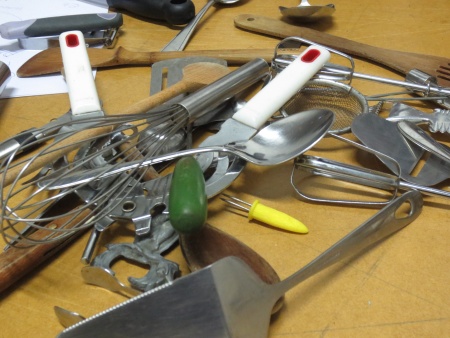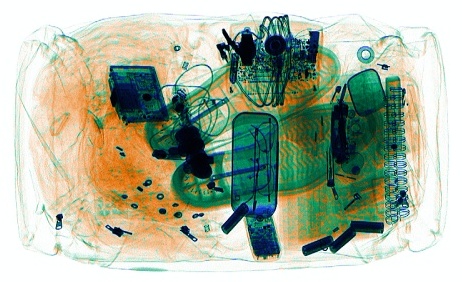Toolbending::Programme2014-2015
Sommaire
- 1 16/09/14 Tiroir de cuisine
- 2 23/09/14 Technobiographie
- 3 30/09/14 cours suspendus
- 4 07/10/14 Ligne de commande, Commande de ligne I
- 5 14/10/14 Erreur, Bug, Glitch
- 6 21/10/14 Ligne de commande, Commande de ligne II
- 7 28/10/14 vacances d'automne
- 8 04/11/14 Python I
- 9 11/11/14 armistice (cours suspendu)
- 10 18/11/14 ---
- 11 25/11/14 Python II
- 12 02/12/14 Toolboxbending/Introduction
- 13 09/12/14 Toolboxbending: Tutoriels
- 14 16/12/14 Edition Spéciale : Nous ne vivons pas dans ce monde là
- 15 23/12/14 vacances d'hiver
- 16 30/12/14 vacances d'hiver
- 17 06/01/15 Toolboxbending/Cotations
16/09/14 Tiroir de cuisine
Go into the kitchen and open the first drawer you come to and the odds are you’ll find the wooden spoon that is used to stir soups and sauces. If this spoon is of a certain age you will see it no longer has its original shape. It has changed, as if a piece had been cut obliquely off the end. Part of it is missing. We have (though not all at once, of course) eaten the missing part mixed up in our soup. [1]
→ Notes
23/09/14 Technobiographie
Who or what is responsible for the act of killing? Is the gun no more than a piece of mediating technology? ... Which of them, the gun or the citizen, is the actor in this situation? Someone else (a citizen-gun, a gun-citizen) ... You are a different person with the gun in your hand; the gun is different with you holding it.[2]
→ Notes
30/09/14 cours suspendus
07/10/14 Ligne de commande, Commande de ligne I
Young Americans who leave their great big homogeneous country and visit some other part of the world typically go through several stages of culture shock: first, dumb wide-eyed astonishment. Then a tentative engagement with the new country’s manners, cuisine, public transit systems and toilets, leading to a brief period of fatuous confidence that they are instant experts on the new country. [3]
→ Notes
14/10/14 Erreur, Bug, Glitch
Dans le discours traditionnel des acteurs du logiciel libre, la libération de la partie informationnelle que constitue le code permet d’en prendre le contrôle : son ouverture permet son appropriation par les utilisateurs qui peuvent alors redéfinir selon leurs propres critères les modalités et finalités de leurs outils. [4]
→ Notes
21/10/14 Ligne de commande, Commande de ligne II
Speech announces the action that will follow along with this antagonism, hence its power, but also importantly speech sometimes fails or is bounced back through various attempts to resist its determining effects. [5]
→ Notes
28/10/14 vacances d'automne
04/11/14 Python I
Dans le discours traditionnel des acteurs du logiciel libre, la libération de la partie informationnelle que constitue le code permet d’en prendre le contrôle : son ouverture permet son appropriation par les utilisateurs qui peuvent alors redéfinir selon leurs propres critères les modalités et finalités de leurs outils. Mais si l’ouverture du code est une invitation à s’engager dans l’élaboration de nos outils, nous nous rendons compte dans la pratique que cette affirmation évacue le fait que le contrôle se fait toujours au détriment de quelqu’un d’autre. [6]
→ Notes
11/11/14 armistice (cours suspendu)
18/11/14 ---
25/11/14 Python II
→ Notes
02/12/14 Toolboxbending/Introduction
Design attempts to produce new conditions or the tools by which to understand and act on current conditions. [7]
→ Notes
09/12/14 Toolboxbending: Tutoriels
(W)hen the hammer ceases to hammer, that is, we cease to be able to hammer with it, then we become aware of it as having a specific form: "The hammer is too heavy." In other words, we only feel the heaviness of the hammer at the moment we cannot use the hammer to perform the action: when the hammer does not hammer. (...) The judgment about the hammer, which gives it a property as being this or that kind of thing, still perceives the hammer in terms of what it can or should do, even in the moment of the failure of the hammer to perform its action. [8]
→ Notes
16/12/14 Edition Spéciale : Nous ne vivons pas dans ce monde là
→ Nous ne vivons pas dans ce monde là
23/12/14 vacances d'hiver
30/12/14 vacances d'hiver
06/01/15 Toolboxbending/Cotations
- ↑ Bruno Munari. Design as art (Penguin, 2009)
- ↑ Bruno Latour. In: Pandora’s Hope (1999)
- ↑ Neal Stephenson. In the beginning was the commandline. (Cryptonomicon, 1999)
- ↑ OSP, ReLearn http://osp.constantvzw.org/blog/wp-content/uploads/osp-bat-10-10-1.pdf
- ↑ Geoff Cox, Speaking Code, MIT press (2012)
- ↑ OSP, Relearn http://ospublish.constantvzw.org/blog/wp-content/uploads/osp-bat-10-10-1.pdf
- ↑ Disalvo, Carl (2013). Adversarial Design
- ↑ Queer Phenomenology: Orientations, Objects, Others. Sarah Achmed, Duke University Press Books 2004





